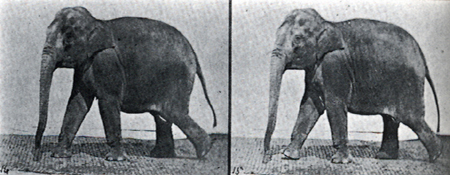 |
||
| Vivid Imagery | ||
| HOME The Art of Memory Origin Myth Vivid Imagery Memory Is Personal Your Inner Monty Python The Use of Places Poetry and Song The Grid System Why It Works The Number Mnemonic Free Ass-sociate Conclusion |
If you’ve ever tried to memorize a set of facts straight, like a list of dates for a history exam, you know how brutally tough it can be. Your eyes can see the facts in the textbook ten times, a hundred times, but they just don’t stick. Try as you might, the details blur together, the information finds loose purchase, and a lot of guesswork enters in when actually trying to recall it for the final exam. Unless, that is, you have associated those facts with unrelated things you already know. Luckily, our brains do this automatically. Even if you aren’t practicing a memory technique, your brain does its best to build associations for the material you are trying to commit to memory. If you didn’t utterly fail that exam, and if you weren’t consciously applying the art of memory (which you probably weren’t), it is because your brain nevertheless managed to find ways to link the new, unfamiliar material you studied to familiar stuff already in your head. The art of memory is just taking this principle and consciously directing and amplifying it. Creating a memory image is a simple matter of substituting the thing you are trying to remember with something familiar, albeit unrelated, that it reminds you of. That’s it. If it is a complex idea with several parts to it, you break it down into those parts; substitute each part with some association that comes to mind, and create a little vignette or scenario with each of those associations. Once you do this, there is no more effort required in remembering. The resulting images will be crazy, and crazy images pretty much stick in the head all by themselves, without any further effort; and it is no problem going backwards, reconstructing the original material from those vivid images. Here's a very mundane example. My friend lives in a big apartment building. To call up to her room and have her buzz you into the building, you must enter a code on a keypad; there is a list of apartment numbers and the corresponding numerical codes. The first couple times I visited, I couldn’t remember what apartment she lived in, and thus didn’t know the code. (I had to call her on my cell phone to ask her.) Well, it turns out that my friend's apartment number is 504, and the code next to her apartment number is 55. You might think that 55 would make it easier to “just naturally” remember the apartment number 504, and vice versa – i.e., the coincidental reappearance of the digit 5 in both numbers. In fact, the opposite was the case. Did she live on the sixth floor and did her code have a six in it? Did she live in room 404 and her code was 45? Looking at the list of apartments and codes, there seemed to be several possible candidates. My friend, like me, is a fan of the Woody Allen film Annie Hall; so she finally said, “Just think of ‘Joey Nichols – Joey Five Cents!’” – a line from the movie. I’ll never forget her code now, precisely because this mnemonic pairs the number 5 with something completely utterly unrelated and moreover, amusingly stupid. I don’t have to search my mental ledger for her apartment code: I just recall the image of Joey Nichols slapping a nickel to his forehead and the young Alvy Singer walking away saying “What an asshole!” The art of memory utilizes the principle that, if you want to remember something you don’t already know (which is the point of memorizing, right?), link it to something you do know. Link the unknown to the known. The more personal the better, because there is nothing you know better than your own experiences. |
All material copyright 2006
Eric Wargo